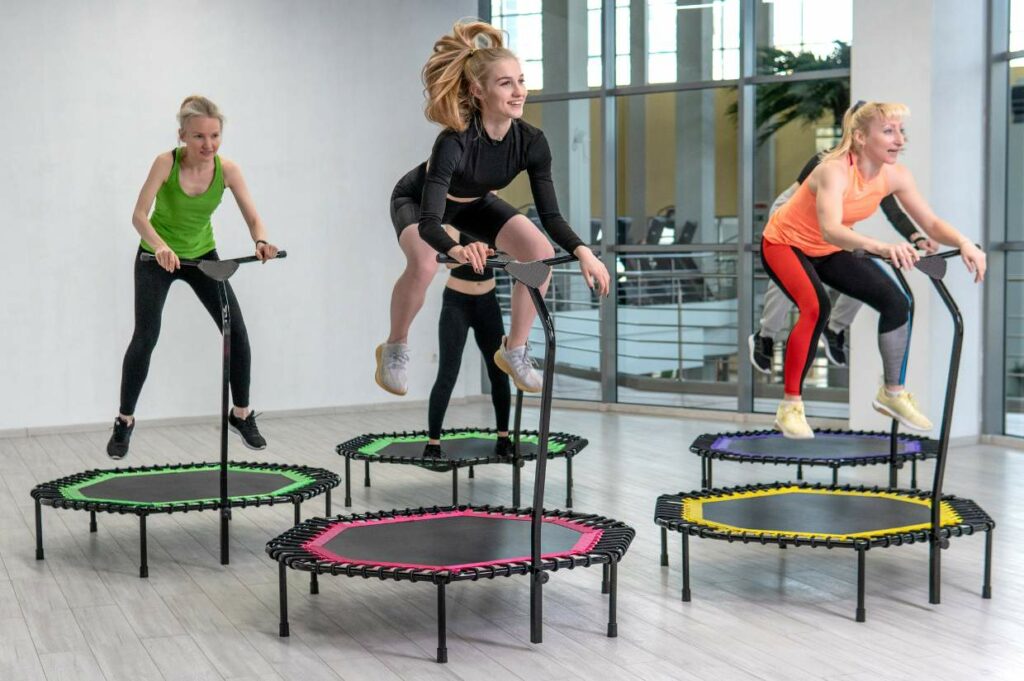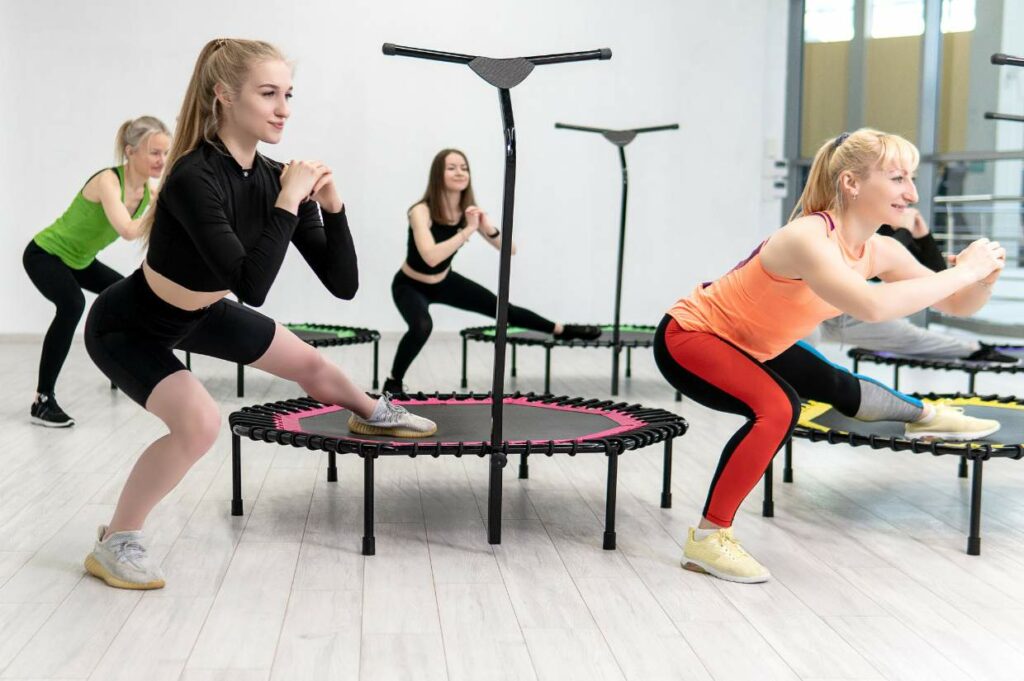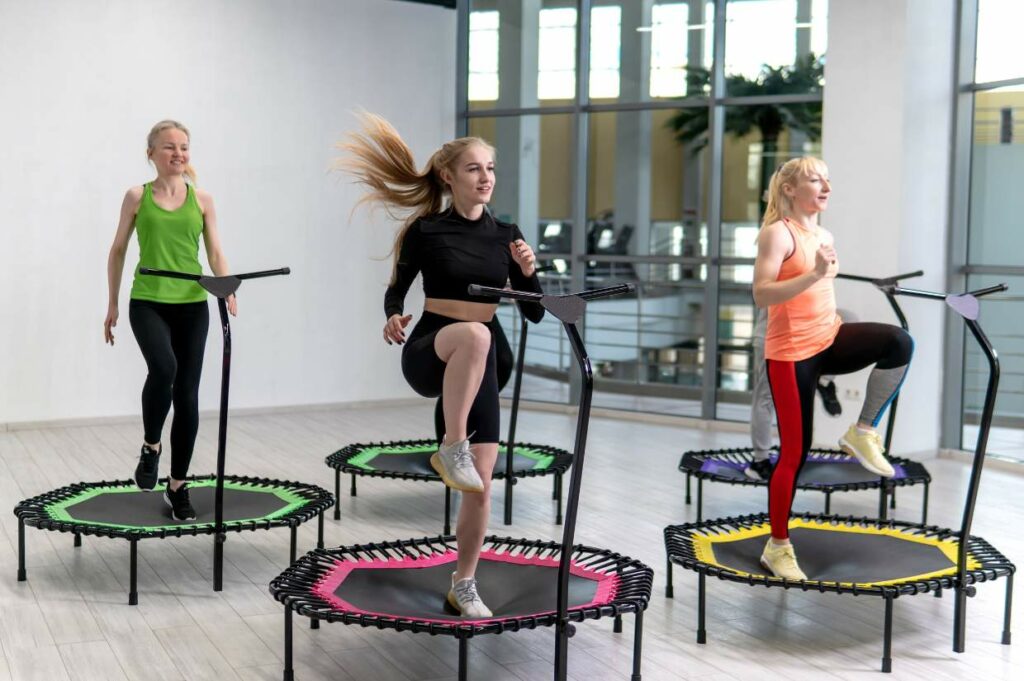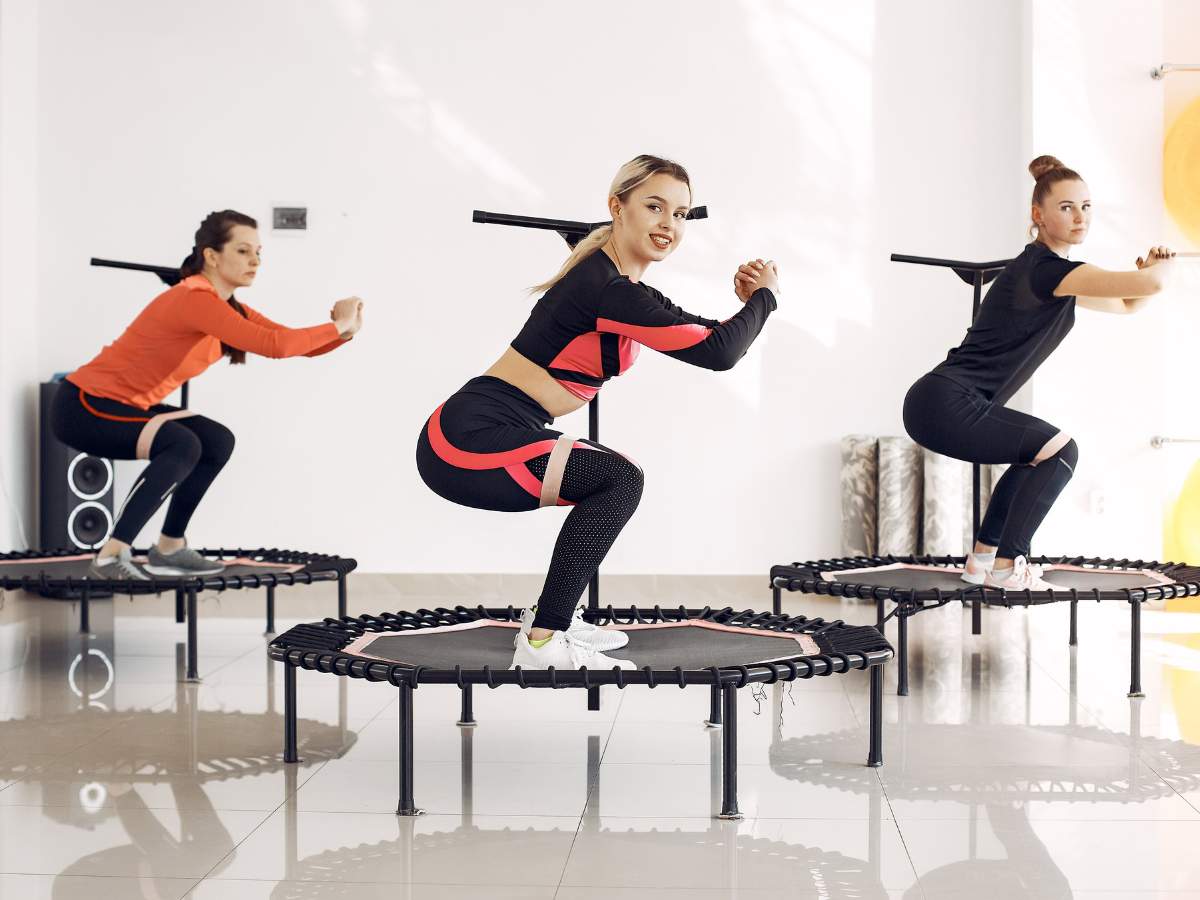Rebounding Skyrockets Energy as The Ultimate Workout Hack
Primal Edge Health participates in the Amazon Services LLC Associates Program and other affiliate programs and therefore, may collect a share of sales or other compensation from the links on this page. This comes at no additional cost to you, and all the prices and availability are accurate at the time of publishing.
Rebounding is a low-impact aerobic exercise that is meant to boost your endurance, strengthen your muscles, raise your heart rate and much, much more. All you need is a mini trampoline and enough space to jump, and you’ll get to reap the benefits of this fun yet gentle exercise.

Jumping on a trampoline sounds like something from your childhood. Yes, trampolines provide a great way for kids to exercise and have fun at the same time, but did you know that trampoline exercise can also be the perfect workout for adults?
A few years ago, I started looking for mild workouts that would be easy on the knees but still get my heart rate pumping. I needed a good form of exercise between more intense workouts, but I didn’t want to overdo it, especially with a busy schedule. Lo and behold, I found rebounding, a quick and easy way to get physical activity with one simple piece of equipment.
Want to jump in on the trend? Here’s what you need to know.
Table of Contents (click to view)
What Is Rebounding?
Rebounding is a form of aerobic exercise done on a mini trampoline. Essentially, the workout is all about jumping up and down, much like using a jump rope or doing jumping jacks. However, it’s a much gentler exercise because your feet are not absorbing the impact of a rigid floor.
That’s why I like turning to this workout when my feet are sore, or I don’t feel like engaging in high-impact cardio. It’s also my favorite late afternoon exercise to reset my circadian rhythm, as it’s not too intense to mess up my energy levels when it’s almost time for bed.
You can combine different types of exercise with rebounding or modify it to fit your needs and preferences. For one, you can bounce up and down without lifting your feet off the trampoline for a lower-impact workout. On the flip side, you can try jumping as high as you can to strengthen your leg muscles and raise your heart rate.
Although discussing rebounding and your new cold plunge tub might raise eyebrows from the neighbor, rebounding is a fantastic exercise. Since it is gentle on the joints, it’s perfect for older adults and those with arthritis, yet still effective for fitness enthusiasts and those looking to lose weight.
Kids can enjoy it too, improving their coordination while having fun. Beginners will find it accessible with easy, gentle bounces, and busy individuals can benefit from quick, effective sessions. Even those recovering from injuries can use rebounding as part of their rehab under professional guidance.

What Are the Benefits of Rebounding?
Adding rebounding to your fitness routine can make way for several health benefits. These may include:
Boosts Energy
According to doctors from Harvard Health, cardiovascular exercises like rebounding help produce more cellular energy, which, in turn, gives you more fuel. Additionally, exercise helps the body use oxygen more efficiently and energizes you throughout the day. More energy comes with other benefits, such as allowing you to engage in more physical activity, keeping you mentally sharp and boosting your immune system.
Helps Protect Your Bones
Rebounding helps support strong bones, protects against bone loss and reduces the risk of fractures, as evidenced by a Journal of the Medical Association of Thailand study on the effects of mini trampoline exercises on bone health. It’s a go-to workout, especially if you’re between 30 and 50 years old when bone loss typically starts.
“Rebounding is a great cardio workout you can do at home. With less impact than running, adding a rebounding workout to your routine can help you improve lower body strength, cardio endurance and prevent osteoporosis by improving bone strength!”
— Shelby, Fit as a Mama Bear
May Help with Weight Loss
A study by the Journal of Sports Medicine and Physical Fitness on the effect of mini trampoline exercise on overweight women showed that rebounding is an effective form of weight loss and overall health improvement. This was evidenced by a decrease in weight, fat and blood pressure in participants.
Plus, rebounding is easier on the joints, bones and respiratory system than running or jogging. This means that it can help you stick to your workout because you’re not constantly out of breath or in pain, which can be a huge roadblock to getting regular physical activity.
Strengthens Muscles
A systematic review in the Sports Medicine journal of the effects of jumping exercises on muscular health revealed that it can increase the strength your skeletal muscles can exert, especially in older adults. Building muscle strength can prevent muscle loss as we age, and having more muscle mass means your body burns more calories, even when at rest.
Personally, I prioritize exercises that help build muscle and always make sure to eat enough protein to fuel synthesis. Aside from being an energy source, rebounding helps me turn protein into muscle, allowing me to do more demanding exercises.
Improves Balance and Coordination
Of course, you’ll need some level of balance and coordination when you start rebounding. However, the requirement is not that high, and you don’t have to start with high-level jumps, anyway.
As you make rebounding a part of your daily movement strategy, jumping on a trampoline can increase your balance, coordination and functional mobility. These benefits are particularly helpful for older adults with an increased risk of falls and a fear of falling. For younger people, good balance and coordination come with the added benefit of improved athleticism.
Increases Lymphatic Drainage
The lymphatic system is made up of tissues and organs that help protect the body from diseases and infections and flush toxins and other unwanted substances from it. It relies on our body’s movements, such as jumping, to initiate lymphatic drainage.
Lymphatic drainage can help reduce inflammation, according to a study published on the Frontiers of Immunology. Increased lymphatic flow or drainage is particularly helpful for people with edema and inflamed skin. It also benefits inflammatory bowel disease (IBS), rheumatoid arthritis and chronic skin inflammation.

Relieves Stress
Along with a glass of wine, exercise is one of my favorite natural stress relievers. However, I have to admit that some forms of exercise are too intense to get the relief that I need.
Rebounding is my go-to alternative for high-intensity workouts. It gives me all those nice endorphins from getting my whole body moving, but it’s gentle enough that I’m not sore for days later. Plus, I’m not tired to the point that I don’t feel like using my red light therapy machine, which is one of my favorite ways to cool down and promote post-exercise recovery.
Plus, rebounding helps me stay motivated. Some days, you don’t want to go to the gym for a full 1-hour workout, so why not hop on the mini trampoline instead?
May Help Digestion
According to the College of Naturopathic Medicine, rebounding may improve digestion by stimulating intestinal movement through its gentle bouncing motion. This movement can improve peristalsis, which are the muscle contractions that move food through the digestive tract. Rebounding also boosts blood flow to digestive organs, promoting better nutrient absorption and efficiency.
More Fun and Portable Workout
Remember all the fun you had jumping on a trampoline as a kid? Well, there’s no reason to miss out on all that enjoyment as an adult, even though you’re doing it on a smaller trampoline.
Another benefit of rebounding is that you can do it almost anywhere. I recommend rebounding in an open, outdoor area with grass in case you need to cushion a fall. However, you can do it indoors or even in front of the TV as long as you have enough space.
Safety Tips for Rebounding
Just like any exercise, rebounding comes with several risks. Keep these safety tips in mind before jumping into this new exercise:
- Make sure you have enough space. As we’ve said before, position your trampoline in a clear area, preferably outdoors. This way, you won’t bump into anything in case you fall.
- Jump within your skill level. Always start slow, like bouncing up and down instead of full-on jumping. Work your way up until you feel more comfortable doing higher-level jumps.
- Inspect your trampoline. Look for any tears or broken pieces before you start each session. Never jump on a flimsy trampoline.
- Stay hydrated. Drink water frequently throughout the day. I love a cold glass of lemon water after a session to replenish my hydration levels, especially if I want something flavorful.
- Wear appropriate footwear: Use supportive shoes with good grip to prevent slipping and provide ankle support.
- Warm up and cool down: Perform a proper warm-up before starting and a cool-down after finishing to prepare your muscles and reduce the risk of injury.
- Maintain proper form: Keep your core engaged, back straight, and knees slightly bent to avoid strain and ensure a safe rebounding experience.
- Consult a Doctor: If you have any medical conditions or concerns, I always recommend consulting with a healthcare professional before starting rebounding. This is especially true if you have any muscle or joint issues.
How to Choose a Good Mini Trampoline for Rebounding
Are you ready to start rebounding? Here are a few things to keep in mind before buying your mini trampoline.
First things first, look for a sturdy frame made from high-quality materials like steel for stability and long life. The trampoline’s mat should be tough and flexible, ideally made from materials like polypropylene that can handle regular use and resist punctures or tears.
Check the springs or bungee cords—good ones offer better bounce and lessen the impact on your joints. Safety is a non-negotiable, so make sure it has a non-slip surface and padded edges to prevent injuries. Consider the weight limit to make sure it supports you comfortably. Adjustable legs are handy for different users and make storage easier.
The Foldable Mini Trampoline from BCAN is a good one to start with. It can handle a maximum load of 330 pounds, is made from durable material, and comes with an adjustable foam handle to help keep you stable while you exercise. Once you’re confident in your skills, you can try their Foldable Mini Trampoline without a bar.
Final Thoughts
Rebounding is an excellent form of exercise that’s easy on the body yet provides so many benefits, such as better energy levels, stronger bones, increased muscle mass and more. If you’re tired of your regular workouts, add rebounding to the mix. Alternatively, make rebounding your main workout and reap the benefits of low-impact cardio.
Portions of this article originally appeared on Food Drink Life.








Reading about the benefits of rebounding got me excited to add it to my fitness routine. It’s refreshing to find a workout that’s effective and enjoyable.
Rooting for you, Samantha I hope it goes well.
Reading about the benefits of rebounding got me excited to add it to my fitness routine. It’s refreshing to find a workout that’s effective and enjoyable.
Definitely worth adding to our fitness routine. Thank you for visiting the post, Alice!